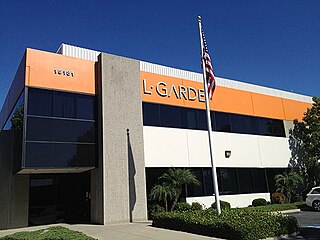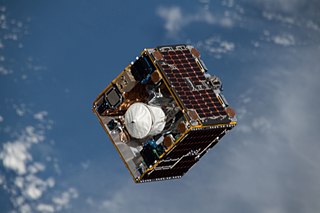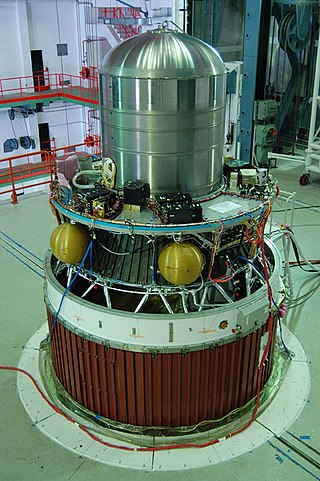
Solar sails are a method of spacecraft propulsion using radiation pressure exerted by sunlight on large surfaces. A number of spaceflight missions to test solar propulsion and navigation have been proposed since the 1980s. The first spacecraft to make use of the technology was IKAROS, launched in 2010.

A CubeSat is a class of small satellite with a form factor of 10 cm (3.9 in) cubes. CubeSats have a mass of no more than 2 kg (4.4 lb) per unit, and often use commercial off-the-shelf (COTS) components for their electronics and structure. CubeSats are deployed into orbit from the International Space Station, or launched as secondary payloads on a launch vehicle. As of December 2023, more than 2,300 CubeSats have been launched.
SNAP-1 is a British nanosatellite in low Earth orbit. The satellite was built at the Surrey Space Centre by Surrey Satellite Technology Ltd (SSTL) and members of the University of Surrey. It was launched on 28 June 2000 on board a Kosmos-3M rocket from the Plesetsk Cosmodrome in northern Russia. It shared the launch with a Russian Nadezhda search and relay spacecraft and the Chinese Tsinghua-1 microsatellite.

NanoSail-D2 was a small satellite built by NASA's Marshall Space Flight Center and Ames Research Center to study the deployment of a solar sail in space. It was a three-unit CubeSat, measuring 30 cm × 10 cm × 10 cm with a mass of 4 kg (8.8 lb). Its solar sail had an area of 10 m2 (110 sq ft), and was deployed in around five seconds.

A number of space tethers have been deployed in space missions. Tether satellites can be used for various purposes including research into tether propulsion, tidal stabilisation and orbital plasma dynamics.
STRaND-1 is a failed 3U CubeSat developed by Surrey University's Surrey Space Centre (SSC) and Surrey Satellite Technology (SSTL). The 4.3 kg (9.5 lb) nanosatellite was launched into orbit on board a PSLV Rocket from India on February 25, 2013, Smartphones have flown in space before inside the International Space Station, and the computer from a PDA launched inside two Japanese CubeSats in 2006 and 2008.

LGarde, also L'Garde or L·Garde, is an American aerospace and defense technology company founded in 1971 in Orange County, CA and is the primary contractor for the Sunjammer spacecraft, the world largest solar sail. The company was an early pioneer of thin-skinned, multi-task inflatable structures used in various military and space applications. At the height of the Cold War, L·Garde developed and manufactured inflatable targets and decoy systems for U.S. military defense, and countermeasure systems for the Strategic Defense Initiative. After the Cold-War, the company used the technologies and manufacturing techniques it had developed to land a contract to design and build the inflatable antenna experiment and other thin-film inflatable space structures using its unique application of rigidizable tube technology. The company's unusual name is an acronym formed by the initials of the founding partners: Bill Larkin, Gayle Bilyeu, Alan Hirasuna, Rich Walstrom, Don Davis. The "E" comes from the Latin term "et al" as a tip to other partners and original employees of the company.

Planet Labs PBC is a publicly trading American Earth imaging company based in San Francisco, California. Their goal is to image the entirety of the Earth daily to monitor changes and pinpoint trends.
Small Payload Quick Return (SPQR) is a NASA Ames Research Center concept to return small payloads from orbit.
Space Tethered Autonomous Robotic Satellite II or STARS-II, was a nanosatellite built by Japan's Kagawa University to test an electrodynamic tether in low Earth orbit, a follow-on to the STARS mission.
PSLV-C28 was the 29th consecutive successful mission of the PSLV program. The PSLV-C28 carried and successfully deployed 5 satellites in the Sun-synchronous orbit. With a launch mass of 320,000 kilograms (710,000 lb) and payload mass of payload mass 1,440 kilograms (3,170 lb), the C28 was the heaviest commercial mission undertaken by the Indian Space Research Organisation and Antrix Corporation. The PSLV-C28 carried three identical optical Earth observation satellites, an optical Earth observation technology demonstrator microsatellite (CBNT-1), and an experimental nanosatellite (De-orbitSail). All the satellites were built by Surrey Satellite Technology (SSTL). Although built by SSTL, the "De-orbitSail" belonged to the Surrey Space Centre.
Alsat-1B is an Algerian satellite operated by the Agence Spatiale Algerienne for agricultural and disaster monitoring. The contract for the mission was signed in July 2014. The satellite is based on the SSTL-100 bus. The satellite weighs 103 kilograms (227 lb) and carries an Earth imaging payload with 12-metre (39 ft) panchromatic imager and 24-metre (79 ft) multispectral cameras.

ArgoMoon is a CubeSat that was launched into a heliocentric orbit on Artemis 1, the maiden flight of the Space Launch System, on 16 November 2022 at 06:47:44 UTC. The objective of the ArgoMoon spacecraft is to take detailed images of the Interim Cryogenic Propulsion Stage following Orion separation, an operation that will demonstrate the ability of a cubesat to conduct precise proximity maneuvers in deep space. ASI has not confirmed nor denied whether this took place, but several images of the Earth and the Moon were taken.
PSLV-C38 was the 40th mission of the Indian Polar Satellite Launch Vehicle (PSLV) program and its 17th mission in the XL configuration. PSLV-C38 successfully carried and deployed 31 satellites in Sun-synchronous orbit. It was launched on 23 June 2017 by the Indian Space Research Organisation (ISRO) from the Satish Dhawan Space Centre at Sriharikota, Andhra Pradesh.
CubeSail is a proposed nanosatellite project by the Surrey Space Centre (SSC) in England. The spacecraft is to be a 3U CubeSat propelled by a 25 m²solar sail. The project is financed and technically supported by aerospace manufacturers Astrium and Surrey Satellite Technology.
CubeSail is a low-cost spacecraft propulsion demonstration mission using two identical 1.5U CubeSat satellites to deploy a 260 m (850 ft) long, 20 m2 (220 sq ft) solar sail ribbon between them. This mission is a first in a series of increasingly complex demonstrations leading up to a full-scale UltraSail heliogyro by the University of Illinois and CU Aerospace.

RemoveDEBRIS was a satellite research project intending to demonstrate various space debris removal technologies. The mission was led by the Surrey Space Centre from the University of Surrey with the satellite's platform manufactured by Surrey Satellite Technology Ltd (SSTL). Partners on the project included Airbus, ArianeGroup, Swiss Center for Electronics and Microtechnology, Inria, Innovative Solutions In Space, Surrey Space Centre, and Stellenbosch University.

PSLV Orbital Experiment Platform (POEM) also known as PSLV Stage 4 Orbital Platform (PS4-OP) is an orbital micro-gravity test bed based on spent fourth stage of PSLV. By adding modular subsystems for power generation, communication and stabilization like photovoltaic cells, Telemetry and Telecommand (TT&C) package, attitude control system, data storage etc to the PSLV fourth stage, it can function as a satellite bus. This augmented stage can then host payloads for up to six months while in orbit, making it useful for qualifying components, gaining space heritage and conduct experiments in micro-gravity conditions. Usually the fourth stage of PSLV is discarded after deployment of satellite and remains in orbit for a significant duration in a passive state as a piece of space debris.















